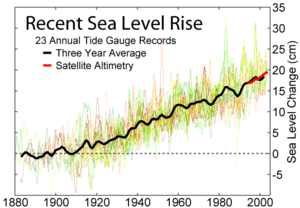 Image via Wikipedia
Image via WikipediaEstimation of sea level change
Global sea levels have traditionally been estimated from tide gauges. As can be imagined they show fluctuations of several meters due to tide and wave action. Identifying sea level changes of a few millimetres a year against this background “noise” is problematic. Since 1993, data are available from satellites. There are two other factors which add to the difficulty of estimate changes in sea level. The first is the way the earth has reacted to the melting of the ice caps. Where major ice melt has taken place, in northern Europe and North America for example, land levels have risen; the post glacial rebound (PGR). Conversely where sea levels have risen and encroached on previously dry areas, land levels have fallen; glacial isostatic adjustment (GIA). (Some sources use the two terms interchangeably) These changes typically average around 4 mm/decade but can be higher in some locations. The second factor is the influence of atmospheric pressure. The changes in pressure can be seasonal and modify levels by 1 metre; often an allowance is made for these pressure difference by applying what is called “an inverted barometer.” As can be seen the adjustments to be made to sea level are of a similar order of magnitude to change in sea level itself. It is generally considered that the rate of change of sea level cannot be accurately estimated for periods of less than 10 years.
Powered by ScribeFire.

No comments:
Post a Comment